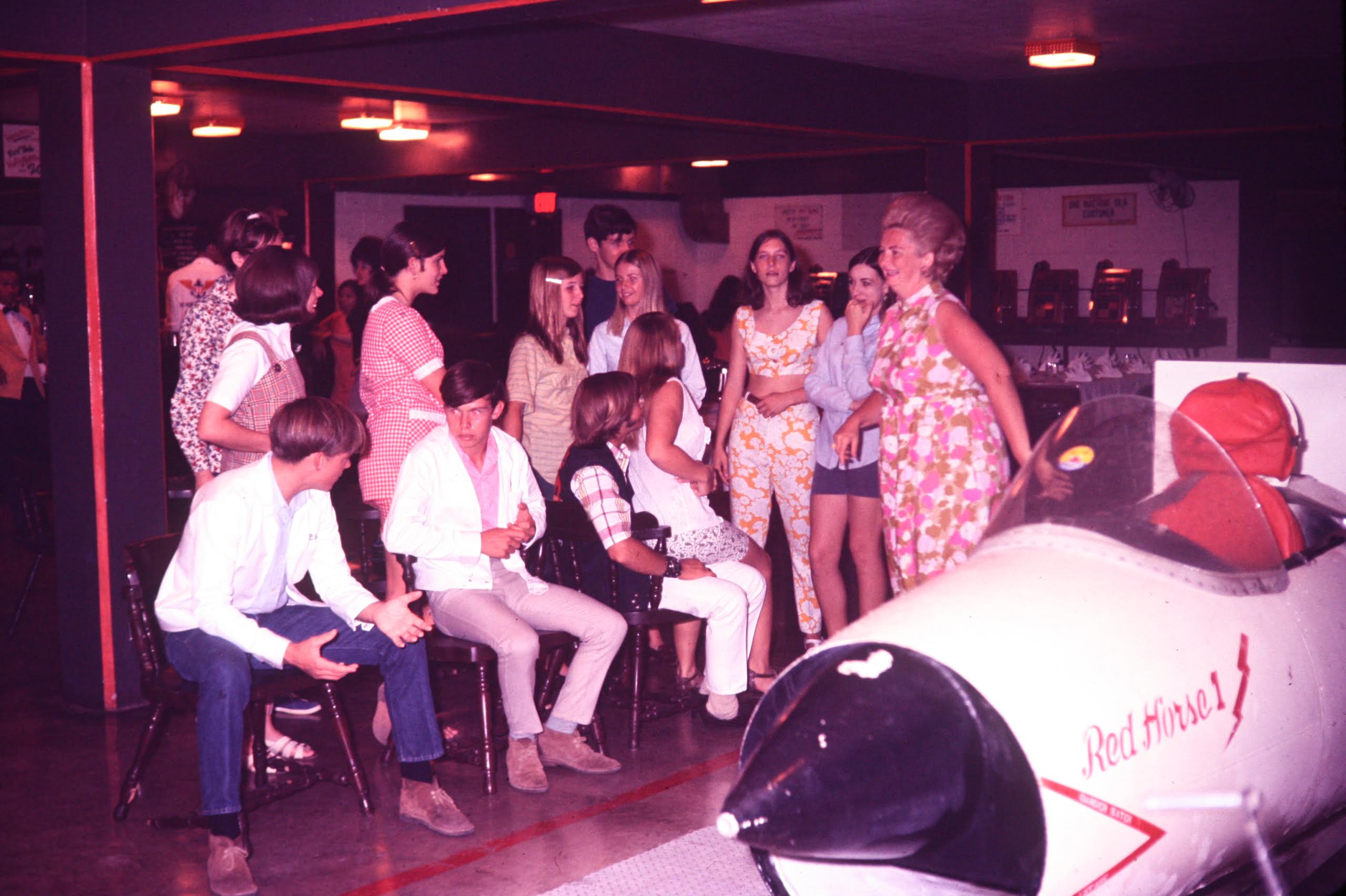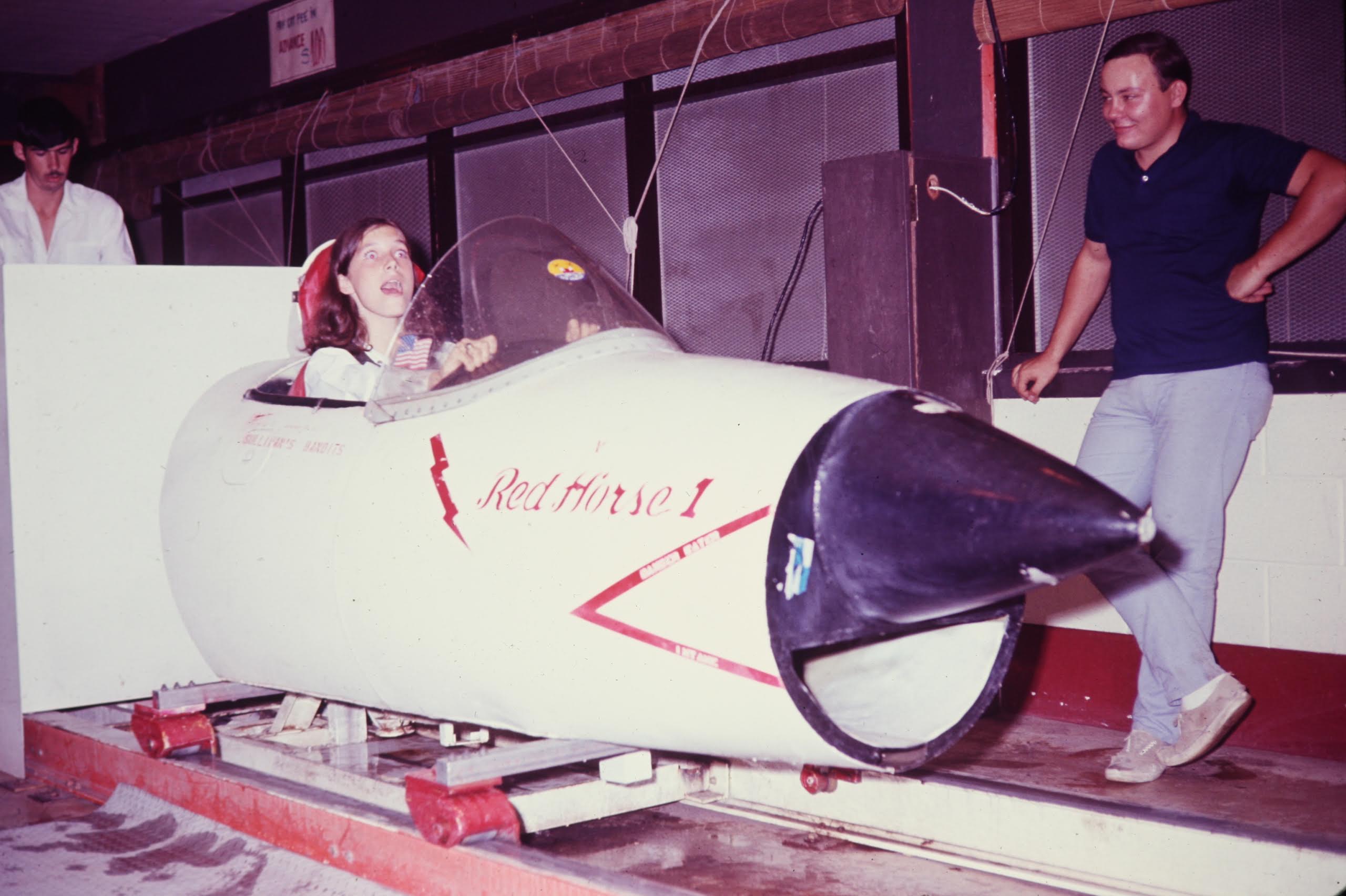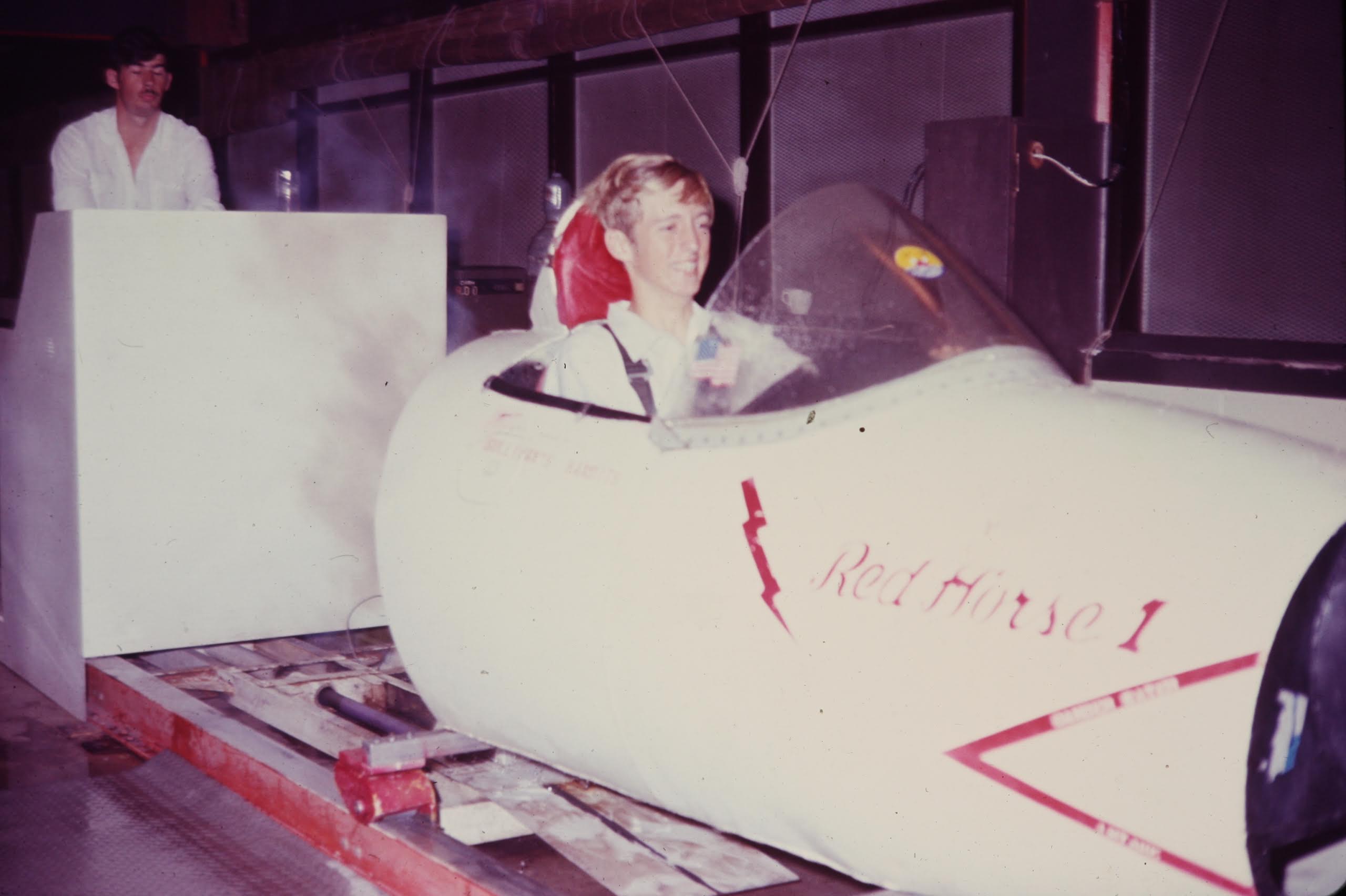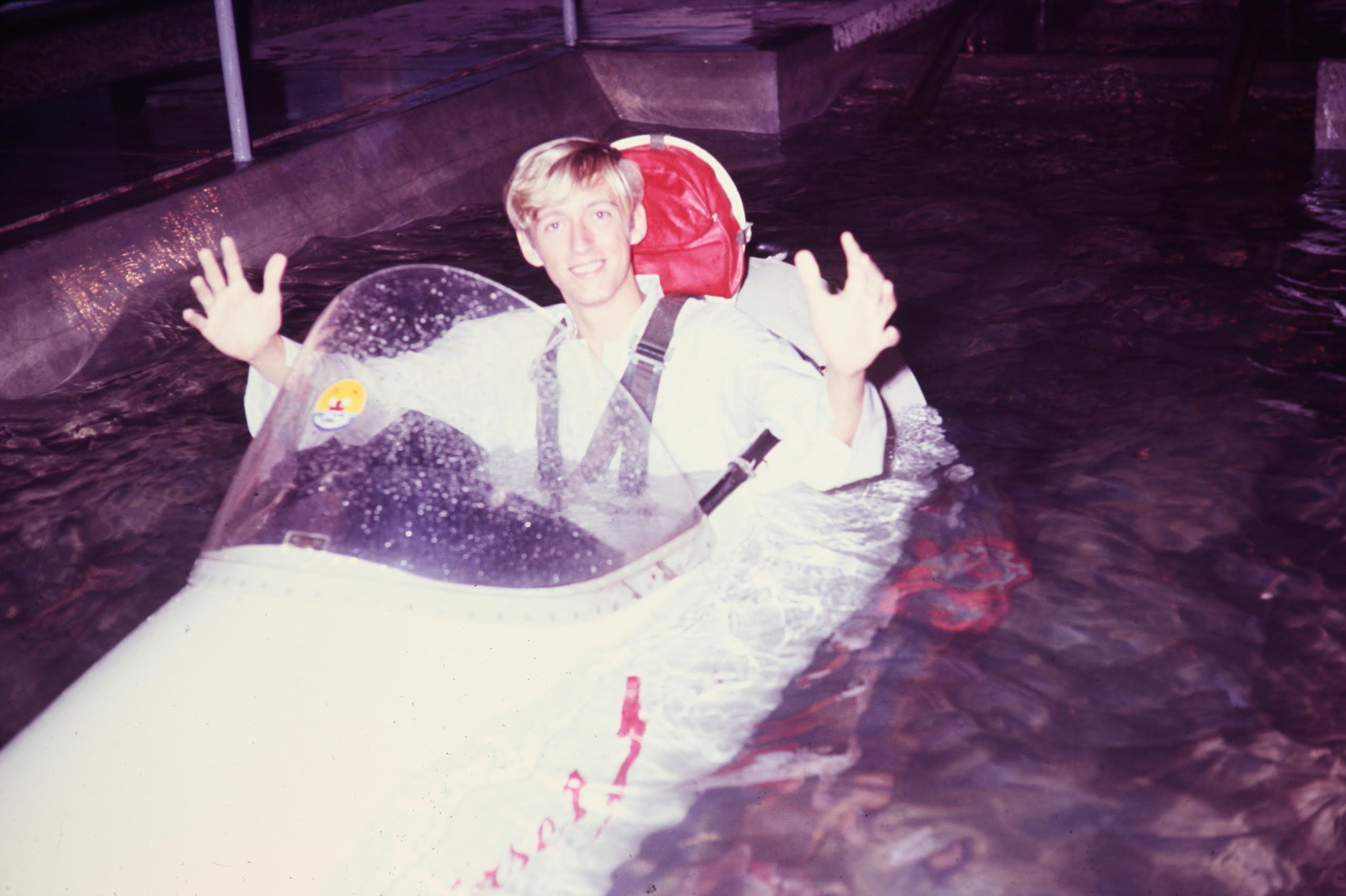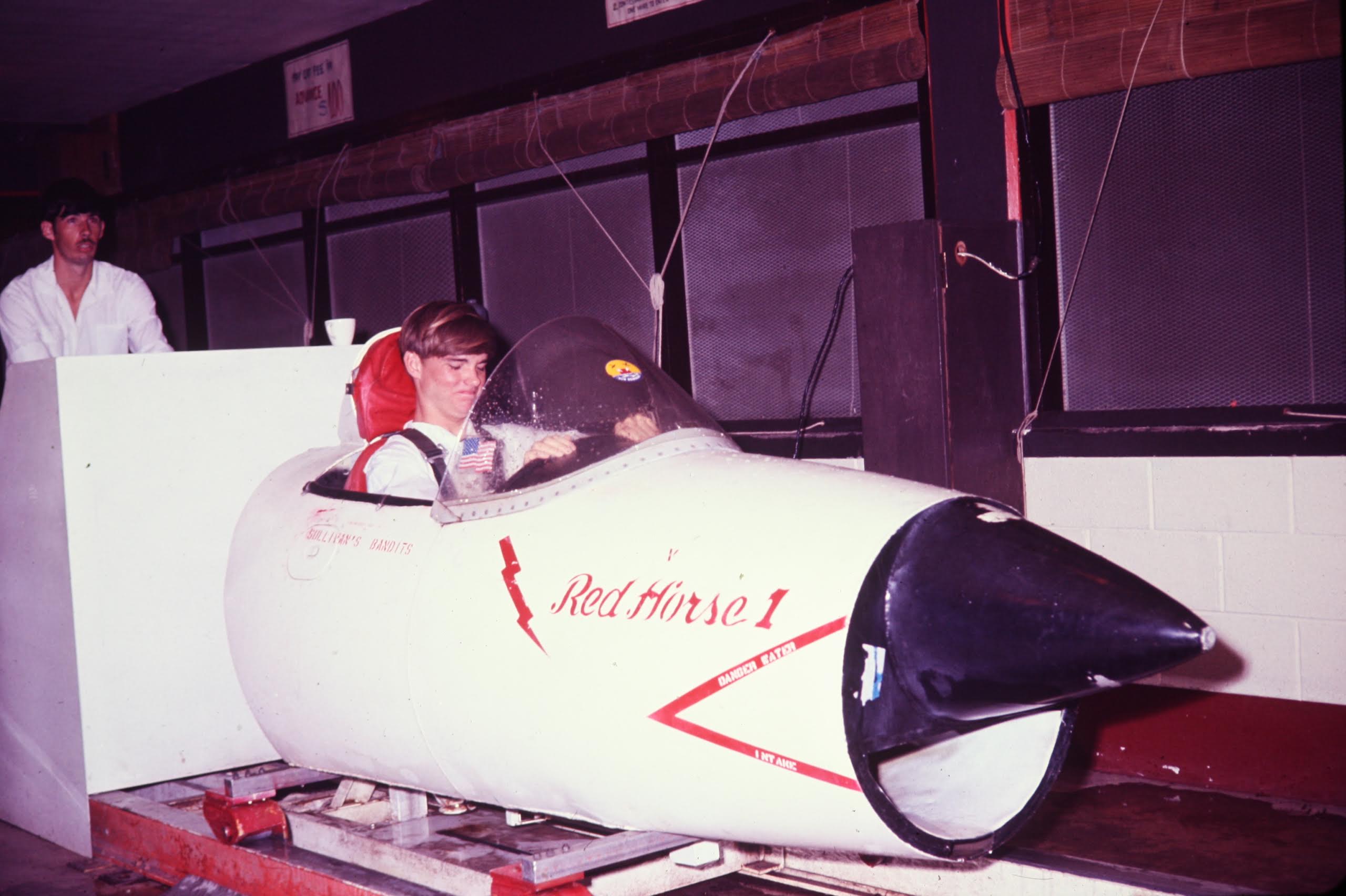On a Saturday night in November of 1969, my father Cdr. John Sullivan, arranged for me, and sister Maura, to have The Cat Room at the Officers Club in Cubi for our joint birthday party. All our friends were there.
If you don’t know what the Cat Room was it’s where the Cubi Catipult was installed for high spirited officers to let off steam and see if they could catch the tailhook or fly off into a pool of water if they failed.
We had a band, food, and the ride for a 3 hour period from 6-9 PM. After that the pilots took over the room until closing. We probably had 30-40 shots at catching the wire but no one did and we all went into the pool! At some point we actually had them push the cockpit to the wire, attach it and push it toward the pool to see what would happen if you did catch the wire. It stopped short of going in the pool so now we knew.
(Editor: If you’re interested in learning more about the Cubi Cat, I’ve inserted an article about it below.)
Some of the folks waiting their turn to ride The Cubi Cat…..This bar was a great room with stage, bar, dance floor, tables, and of course The Cat Ride. It was located just out back of the main Cubi O’Club on top of the mountain overlooking the runway at Cubi Point.
My sister Maura getting ready to be launched as the Aircraft Intermediate Maintenance Department (AIMD) guys watch. The off duty crew from AIMD made a lot of good spending money running the Cat Ride for The O’Club. They were all good guys.
This is me at the moment of launch……I’m heading down toward the pool……you can see the smoke coming out the back….
Ok….now I’m in the pool and have to be wrenched back out for the next person’s try.
Ed Smith preparing to be fired down the track of The Catapult Ride.
The Legend Of The Cubi Cat
If you’re old enough to have served in the Navy or Marine Corps during the Vietnam War and particularly if you were an aviator, chances are you’ve heard of the infamous Cubi Point Catapult. Cubi Point Naval Air Station and the adjoining Subic Bay Naval Base in the Philippines was a place where war-weary Navy and Marine Corps aviators, Marines and Sailors, could let off a little steam after flying combat missions over Vietnam or spending weeks on the gunline aboard ships on Yankee Station. The managers of the Cubi Point Officers’ Club, as well as their counterparts at the other officer and enlisted clubs, were forever tasked with devising new and challenging ways of keeping the warriors entertained. Enter Cmdr. John L. Sullivan and the now famous Cubi Point Officers’ Club catapult.
The catapult at the Cubi Point Officers’ Club came into existence in 1969 and immediately created a division within naval air among those who had ridden the cat and caught the wire, and those who had ridden the cat and missed the wire and gotten soaked. The escapades of Navy and Marine pilots at the Cubi Point Officers’ Club, according to Sullivan, is the stuff of legend. “These tale will be handed down and embellished as long as we have aircraft carriers in that part of the world,” Sullivan said in an article he wrote for Wings of Gold magazine.
One of these escapades, according to the retired commander who now lives in St. Mary’s County, involved catapulting a squadron mate down a half dozen stairs in a chair from the bar upstairs onto the dance floor below. “The fact the chair had castors helped little on the stairs. Rarely did a pilot make it down the stairs and onto the dance floor in an upright posture. Most arrived on the dance floor in a crumpled mess. The practice often ended with disastrous results,” Sullivan said. “There were broken bones, severe strains, small concussions and numerous other injuries that grounded crack combat pilots,” former Commander in Chief, Pacific Fleet, Adm. Maurice ‘Mickey’ Weisner, said in a recent phone interview. Weisner said that he and Vice Adm. Ralph Cousins, commander, Task Force-77, suggested to Capt. ‘Red Horse’ Meyers, NAS Cubi Point, that the chair catapulting be eliminated because of the injuries.
At the time, Sullivan was the Aircraft Intermediate Maintenance Department (AIMD) officer. “I was called to the skipper’s office and asked to come up with a solution,” Sullivan recalls. “After a great deal of consultation with my maintenance officers we realized we had an excellent window of opportunity. A new lower club extension to replace an old bamboo bar was in progress. From that point on we let our imaginations run wild.”
Heading off to the surplus yard, Sullivan and his band of AIMD scavengers liberated a banged up refueling tank which was quickly converted by the metal smiths into something resembling an A-7 Corsair II. The ‘aircraft,’ Sullivan recalls, was 6-feet long had shoulder straps and a safety belt and was equipped with a stick that, when pulled back sharply, released a hook in the rear of the vehicle to allow arrestment. Propulsion was provided by pressurized nitrogen tanks hooked up to a manifold. “This arrangement provided enough power to propel the vehicle to 15 mph in the first two feet,” said Sullivan. “Acceleration of zero to 15 mph in two feet is the equivalent of the G force of World War II hydraulic catapults.
“Beyond the exit from the club was a pool of water 3-1/2 feet deep. Each pilot had 6 inches to play with if he was to make a successful arrestment. “We named the vehicle ‘Red Horse One’ in honor of our skipper, Capt. Meyers. Successful pilots, according to the commander, were held in high esteem by their peers and their names were inscribed in gold letters on the club’s Wall of Fame.
“Reaction time was short because the wire was some 14 feet from the nose of the vehicle. The downward curvature of the track had to be precise. The rollers would bind if the curvature were too sharp. “Since the pool water was the force that stopped the vehicle, we had to get the vehicle as deeply and as quickly into the pool as possible. Engineers from the Strategic Aircraft Repair Team used their ‘slip sticks’ to solve the problem. The vehicle was retrieved from the water by a mechanical wench and cable connected to an eye welded to the back of the A-7.
Sullivan said that Rear Adm. Roy Isaman, (Naval Air Test Center commander, 1971-74), had a bronze plaque made in Hong Kong which was bolted to the wall next to the catapult with the inscription, ‘Red Horse Cat-House.’ “The first night the catapult was in operation it attracted a huge crowd. Rear Adm. Isaman was the first to ride the vehicle after it was declared safe by the BIS (Board of Inspection and Survey). No problem since I had recently arrived from the test center at Patuxent River and was declared the BIS representative,” Sullivan recalls.
“Rear Adm. Isaman manned the cockpit, saluted and was launched. He dropped the hook early and we awaited the hook skip but it didn’t happen. Instead the hook caught the rubber we had attached to the steel bumper short of the wire. The hook tore the rubber from the bumper and caught the wire. To the howl of the disappointed junior officers, there was no wet admiral this time. Isaman became the first pilot to trap in the vehicle. “After being presented with a bottle of champagne, Isaman’s name was enshrined on the ‘Wall of Fame.’ Some 40 pilots rode the Cat that night before another successfully trapped,” Sullivan laughed.
Word of the Cat quickly spread throughout Southeast Asia and even attracted Air Force F-4 pilots from Clarke AFB. “They would come swaggering in loudly claiming they were equal to the task. Each and every one of them failed to catch the wire, much to the delight of the Navy onlookers.
“Enlisted men from AIMD operated and maintained the catapult during their off time. They were compensated for their work from funds we took in for the operation of the Cat. It cost nothing to ride the Cat,” Sullivan emphasized, “providing they caught the wire. However, it cost $5 if the rider required rescue from the pool.”
Sullivan said that of the many dignitaries, who attempted to ride the cat, his favorite was Under Secretary of the Navy John Warner (now a U.S. Senator from Virginia). “After flying in from Japan the secretary was taken to the club for lunch by Rear Adm. Isaman and Capt. Meyers. The secretary had heard of the Cubi CAT and unhesitatingly requested to ride it. Capt. Meyers looked at me; I nodded and immediately took steps to get a crew ready. Word spread rapidly that Under Secretary of the Navy John Warner would try his luck. The club was soon packed with onlookers.
“Before launch we outfitted the secretary in a set of white linen coveralls with ‘Red Horse Cat House’ embossed in bright red letters on the back. Amid the cheers of the onlookers, the secretary bravely launched and promptly landed in the pool. We catapulted him five times after that and each time he got wet. The skipper kicked the bumper plate back about an inch each time hoping he would catch the wire. While the official never noticed this, we all did. He told the skipper after his fifth trip into the pool,’it can’t be done.’
“By this time the bumper was back some 12 inches from the wire and was an easy arrest for a pilot who had a launch or two on the CAT under his belt. So ‘Red Horse,’ in his tropical whites, strapped in. Before launch one of the junior officers kicked the bumper forward to its original 6-inch position. Meyers launched and to the delight of the visiting official, settled ignominiously into the pool.=
Secretary Warner wouldn’t take off the coveralls. He and the skipper, both wringing wet, set down to lunch with dry colleagues. “Several hours later, still wearing the coveralls, the secretary boarded his aircraft. “The tale of his Cat adventures would be told at the Pentagon, he informed us and the coveralls would be testimony to the validity of his tale.”
Sullivan completed his tour at Cubi Point in 1971 and returned to Patuxent River. “I am happy to say there were no injuries from riding the Cat during that period, only wounded pride,” Sullivan says. Sullivan returned to Cubi Point in 1979, then employed by Grumman Aerospace Corporation as the Project Manager for the C-2 COD. Much to his dismay the Cat was gone. “The tracks were covered and the pool was filled with cement.” Introduced to the new club manager, he asked if I could assist him in putting in a new Cat. I felt like a dinosaur whose time had passed. I believed that as long as there was a Cubi Point there would be a fun place for naval aviators to unwind. In the midst of it all would be the “Cat” and the ‘Wall of Fame.’ Now both are gone. What remains is my fond memories of the officers and men of AIMD whose ingenuity and hard work made the “Cat” a reality in 1969. “Today it remains a 7th Fleet legend.”

